Reproduction of the phalaenopsis orchid at home with children and seeds (with video)
Reproduction of phalaenopsis at home is done by seeds and vegetatively.
Vegetative reproduction. When lateral processes appear, they can be deposited if they have begun to develop their own roots. Sometimes young babies emerge from knots on the peduncle. If the plant you are replanting is too tall and has good roots, you can divide it up, leaving a stump with several roots. Often a young orchid begins to develop at the top of the old part. When she gets stronger, she can be planted. When breeding phalaenopsis orchids, children of any type should be planted in sphagnum or soft osmund fibers, and then covered with plastic wrap along with the pot to create moist air. Very rarely, babies develop on the roots.
Growing from seeds. Pollination is carried out in the same way as in other genera. The pods ripen quickly, 5–6 months after pollination. A ripe pod dries up and opens quite suddenly, so it is best to cover it to avoid shedding the seeds. When growing phalaenopsis, remember that seeds lose their germination rather quickly, although they can be stored in the refrigerator for a short time. They are also more sensitive to disinfectants than other varieties. Calcium hypochlorite is the most harmless remedy, but seeds should not remain in its solution for more than a day. When propagating phalaenopsis at home, seeds are best sown from a green pod. Remove the pod at least one month before normal opening; the best time is considered to be 4–4.5 months after pollination. Seedlings grow quickly and are ready to be transplanted from flasks at about 6 months. They can be transplanted into boxes or common bowls. Then they should be covered with glass to create a warm, stuffy atmosphere. When ready for custom planting, use 10cm pots.
Possible problems: if the plant looks healthy, but does not bloom, this means that it needs to be shaken up - in the fall, keep in very dry conditions, without watering for a month or more. Dry spots on the leaves are usually caused by sunburn. To avoid this, you need to move the pot away from the glass.
This video shows the reproduction of the Phalaenopsis orchid at home by seeds and vegetatively:
The nuances of growing at home
There are several important rules to keep in mind when growing a yellow orchid at home:
If a plant is infected with a disease, it must be identified.
Otherwise, it will not be possible to save the flower: the orchid will very quickly die from improper treatment.
It is important to provide the right microclimate. It is recommended to put the flower on any window where there is a bright light
However, in the south, there is a risk of getting burned if the light is not diffused.
Watering should be moderate and infrequent. From time to time it is worth arranging souls for the plant.
A yellow orchid should be transplanted when the plant is not blooming. In addition, fertilization should not be applied at the same time.

Yellow orchids are really popular with flower growers. They are extraordinarily beautiful and relatively easy to care for. You just need to know what activities to carry out and in what order.
Phalaenopsis mini - home care
After buying a miniature orchid from a flower shop, you should provide it with optimal conditions so that it can endure stress with the least loss, take root well in an unfamiliar environment and harm other plants that are in the house.To do this, you need to create a quarantine for her for about two weeks. Place the new plant pot away from other house flowers. In addition, it is necessary to ensure that it is protected from direct sunlight. It is not recommended to feed Phalaenopsis with fertilizers during the adaptation period.
If we talk about the reproduction of a dwarf orchid, then it can be carried out only using the vegetative method. To do this, you need to shorten the stem, cut it as close as possible directly to the kidney, the cut section must be waxed so that the arrow does not dry out. A special agent is applied to the kidney - cytokinin paste. After the roots appear at the "baby", you should plant it in your pot.
Transfer
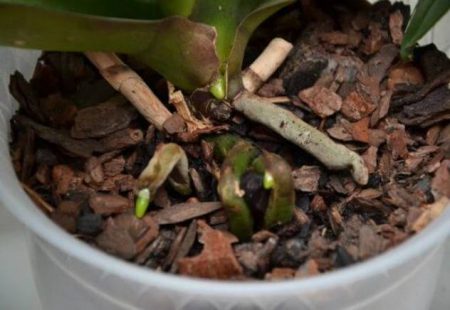
It is not often necessary to transplant a small phalaenopsis: for the first time, the transplant should be carried out no earlier than three years later. This is due to the fact that such a procedure is considered traumatic for the roots, for this reason it is highly undesirable to transplant the plant if there is no urgent need.
Before replanting an orchid, you should carefully examine the roots, remove all injured or dried and rotten processes, and pour wood ash on the cut site. The container in which it is planned to plant the dwarf phalaenopsis must be placed in the bark, and moss should be placed in those zones in which it will remain between the bark and the root system.
Important! Caring for a small orchid will be easier if it grows in a transparent pot - this way you can always assess the condition of the roots.
Watering
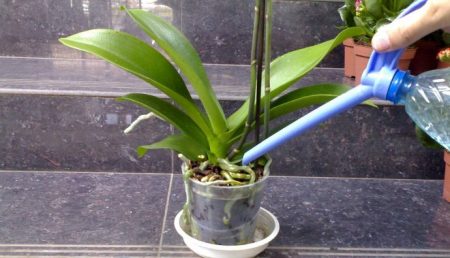
For the normal development and health of mini phalaenopsis, it is necessary to provide it with proper watering. During the winter months, when the flower is in a calm state, you can water no more than once every two weeks. But in the summer months, when there is an active growth of all orchids, watering should be carried out at least twice a week.
Do not moisturize the substrate until it is completely dry. It is the well-dried soil that provides the required amount of oxygen to the root system of a small orchid, without which the process of photosynthesis is impossible.
The pygmy phalaenopsis loves watering by immersion. To do this, you need to put a pot with a flower in a container in which settled water at room temperature is poured, and leave for 20 minutes. It is not recommended to immerse the plant for a longer time, as this can cause the roots to rot.
Fertilization
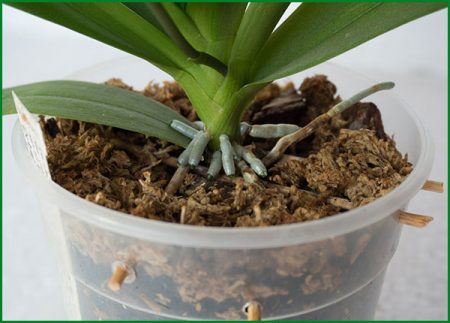
For the normal growth of dwarf phalaenopsis, it must be fed regularly. Mini-varieties are usually fertilized only during the active growing season. It is better to choose special ready-made mixtures that are created specifically for this type of indoor flower. Fertilizer for other plants can burn sensitive roots and kill the miniature orchid.
Lighting
Such a plant tolerates shade well. In the summer months it is necessary to protect them from direct exposure to the sun's rays. A window sill or area near a window that is not illuminated by the sun will be an ideal place for phalaenopsis. Whether or not a flower has enough light can be determined by the leaves. If they brighten or turn yellow, this indicates an overabundance of lighting, if they darken, on the contrary, there is not enough light for the phalaenopsis.
Papiopedilum
Representatives of this genus of orchids are often called Slippers or Venus's slippers. Antique footwear resembles a large protruding lip-pouch.
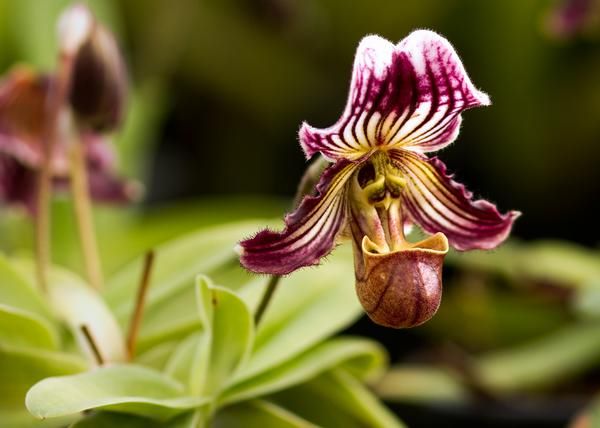
Paphiopedilum fairrieanum from the eastern Himalayas.
Countries are considered the homeland:
- South and Southeast Asia:
- Indonesia;
- India;
- Vietnam;
- Philippines;
- China;
- Nepal;
- Kalimantan;
- New Guinea.
- But several species grow in the forests of central Russia;
- And most of Siberia.
Among several dozen species and hybrids, most are terrestrial orchids, but epiphytes are also found. The plant is sympodial, does not form pseudobulbs. Peduncle from 10 to 50 cm, single flowers, rarely 2-3 at the top of one stem.
Sukhakula
Native to the tropical rainforest of the Northeast of Thailand. A shade-loving, moisture-demanding terrestrial plant, it takes root well on a loose fertile substrate.
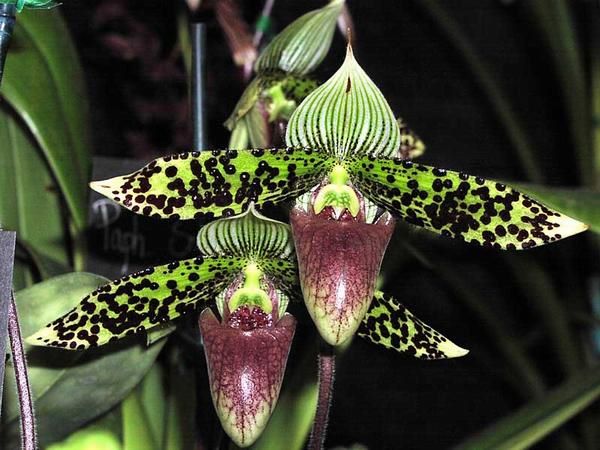
Pafiopedilum Sukhakula.
Leaves:
- Sharp;
- Long;
- Elliptical;
- With dark patterns on pale green platinum.
Large, up to 12 cm, flowers sit on brownish, heavily pubescent peduncles. Lateral petals are pale, yellowish-green, covered with a scattering of spots. The upper petal is concave with green strokes. The upper part of the lip is brown, sometimes with burgundy tones, the lower part is light, greenish.
Horny
It occurs naturally in Vietnam and Thailand. The bright flower is distinguished by a wide upper heart-shaped petal. Along the white field along the veins, there are dense streaks forming a dense wine-red coating in the center, the edges are light. Lateral petals are greenish with deep red stripes. The lip is dark red, sometimes brownish.

Paphiopedilum is corpuscular.
The size of the flowers is the largest in the genus Papiopedium.
Step by step care instructions
Seat selection
Suitable window for placement - west and east. It can also be placed on the southern one, but shading with curtains, blinds or a screen should be organized.
Preparing the soil and pot for planting
The pot must be of a suitable size and well ventilated. It can be made of plastic or glass, you can use a wooden or wicker basket. The best option is a transparent container that allows you to monitor the state of the root system and gives it maximum access to light.
The substrate should consist of the following components:
- perlite;
- vermiculite;
- polystyrene;
- leafy land;
- Pine cones;
- sphagnum;
- peat (lowland or high-moor);
- charcoal;
- coir;
- expanded clay;
- bark (preferably pine).
All components are thoroughly washed under the shower, steamed, dried and crushed. For drainage, take broken red brick and small crushed stone.
Styrofoam cannot be used - it swells during watering and can gradually push the roots out of the pot.
Humidity
Suitable air humidity is 50-70%. The container with a flower is best placed on a tray with water and pebbles.
The orchid roots should not touch the water in the sump.
Lighting
If there is a lack of natural light in the winter months, additional lighting with lamps is needed - at least 12 hours.
Phelanopsis has a tendency to turn towards the stream of light. In order for the plant not to lose its decorative appearance and fall out of the pot, it must be periodically (once every 2 weeks) turned 180 degrees. This should not be done during the budding period.
Watering
For irrigation, purified water at room temperature is used. Phelanopsis is watered 2 times a week. The earth ball should dry completely between waterings. Do not water at night!
Even on hot summer days, phalaenopsis should not be sprayed.
If water droplets fall into the core and the sinuses between the leaves, they can rot, and if on the leaves, this will lead to burns due to exposure to sunlight.
We suggest watching a video on how to properly water the Phalaenopsis orchid:
Top dressing
Fertilizer should be a special water-soluble or complex mineral fertilizer. It is bred in a proportion of 1 g. for 1 liter of water and applied after watering. There is no need to feed from October to March.
Transfer
The transplant is carried out every three years to replace the substrate, as well as in cases when:
- the roots are pale or rotten;
- the roots have grown so much that the flower no longer fits in the pot;
- when the children have grown up and the orchid must be divided.
The roots of the orchid are fragile and easily damaged, so the transplant must be carried out carefully. They are soaked in warm water with potassium permanganate, dry and rotten areas are cut off, the cut sites are disinfected with crushed activated carbon, cinnamon or garlic solution. You can keep the roots in Fitosporin solution for 30-40 minutes.
We offer you to watch a video on how to transplant Phalaenopsis correctly:
You can find more information about phalaenopsis care here.
How to care for a plant?
There are certain requirements for caring for an orchid
It is important to adhere to them so that there are no problems with growth and flowering. If the requirements are severely violated, there is a risk of disease.
It is worth considering the rules of care in more detail.
Maintaining a microclimate
The yellow orchid is very sensitive to any changes in the microclimate. Therefore, you need to be especially careful during any exposure to the flower.
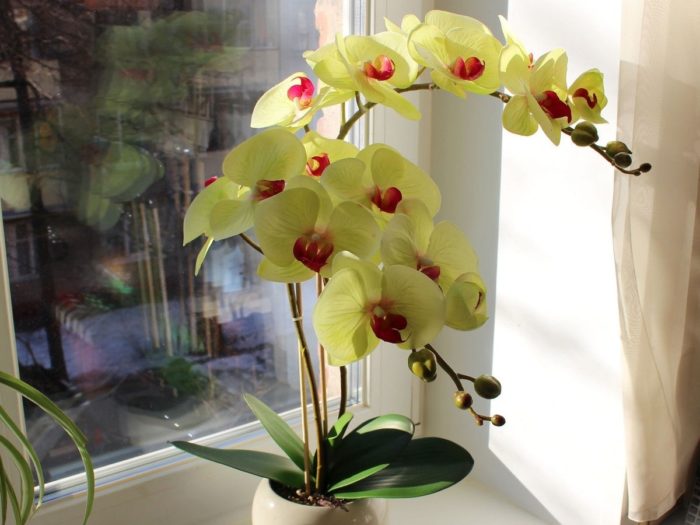
Here are the optimal conditions for growing an orchid at home:
- lower temperature limit - +22 degrees;
- the upper temperature threshold is +27 degrees;
- at night, a decrease to +18 degrees is possible;
- it is required that temperature differences are no more than five degrees;
- exposure to direct sunlight is prohibited;
- drafts are unacceptable.
Reference. It is quite normal that the room is periodically ventilated. If there is an orchid in it, measures must be taken to protect the plant. For this, a plastic circle or other device is placed next to it so that the wind does not blow on the flower.
It is also necessary to monitor the humidity of the air. The flower loves to keep it at 80–90%. To do this, you need to install a humidifier or a container with water in the room.
Watering
Particular attention must be paid to watering. If you flood the plant too much, it starts to rot.
Here are the basic rules for moisturizing an orchid:
- Water it once every 7-10 days if the plant is not blooming.
- During the flowering period, it is watered every 10–12 days.
- If it's hot outside, watering is done every 2-4 days.
- You can determine whether to water by looking at the topsoil: if it's dry, it should be moistened.
- Spraying is required periodically. However, water should not get into the rosettes of the leaves, as this can cause the decay process.
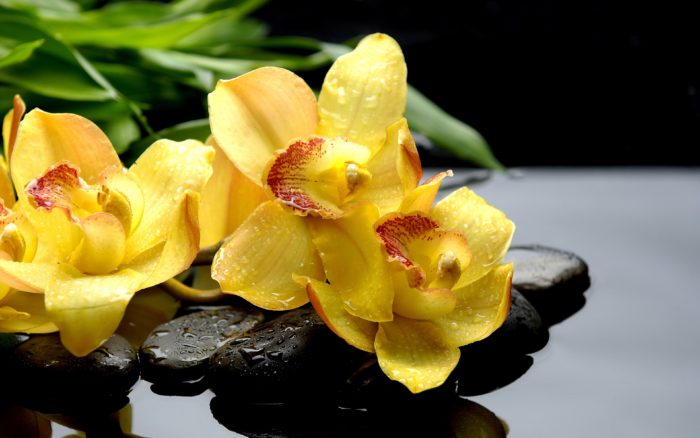
Important. If moisture enters the leaf outlet, it is removed with a cotton swab so that rotting does not begin
Residual moisture from the pan is poured out about 10 minutes after watering. This will help prevent root rot.
Top dressing
It is optional, but highly recommended, to fertilize the soil with the orchid. This allows for more abundant flowering and accelerates the growth of the plant. At the same time, there are some rules for applying top dressing:
- First you need to choose a fertilizer based on potassium, phosphorus and superphosphate. Gardening stores have special blends for orchids.
- The mixture is diluted with water, but the dosage for the first time should be less than in the instructions.
- If everything is in order, then after 20 days, minerals are added according to the instructions.
Reference. Depending on the type of orchid, different amounts of minerals are required. You can only find out the optimal dosage of components by experience. If the flower responds normally to the first feeding, you can use the selected fertilizer in the future. Its frequency is every 20 days. In winter, it is also necessary to fertilize the plant, since the flower is evergreen and does not have a hibernation period.
Transplant and reproduction
A flower transplant is the same as planting. But you need to carefully remove it from the pot so as not to damage the roots. How quickly the plant recovers and returns to growth depends on the integrity of the root system.
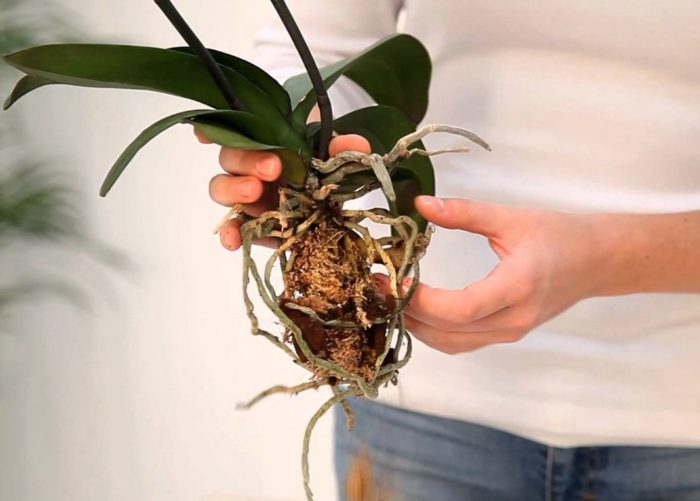
Reproduction is carried out in the following ways:
- dividing the bush;
- root children;
- cuttings;
- children on a peduncle;
- seeds.
Reference. The reproduction process of yellow orchids is very complex. It should be understood that the plant will not bloom from 2 to 10 years. Therefore, flower growers often prefer to buy an already germinated orchid in a specialized store. She will be able to bloom in a year. And with proper care and in the year of purchase.
Types of phalaenopsis orchids: photo, name and description
The following are the most common types of phalaenopsis orchids with photos, names and descriptions.
According to the structure of the flower, phalaenopsis are divided into two groups:
Group I, Euphabenopsis, is characterized by whiskers on the lip and wider petals than sepals.
Group II, Stauroglottis, has sepal-like petals and a lip without processes. In both groups, a variably shaped lip connects to a widened column base called the column "leg".
Group I, Euphalаenopsis
The lip of plants of this group has two processes either in the form of tendrils or in the form of thin horns. The petals are wider than the sepals and are compressed at their base into thin "claws".

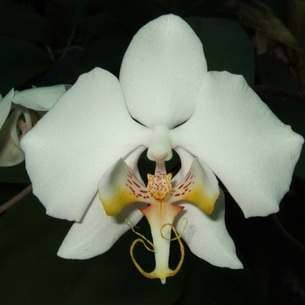
Phalaenopsis amabilis - Phalaenopsis amabilis. One of the most popular species of the genus, together with Phal. aphrodite is the basis of most modern white hybrids. The leaves are pure green, 10–30 cm long. The long, curved peduncles bear many flowers, each seven to twenty in diameter. The pure white petals and sepals contrast with the lip, which is highlighted in yellow, with red spots and stripes, and bears a pair of wavy tendrils falling from the outer end. If the peduncle is cut just below the node that gave the first flower, it releases secondary peduncles. The plant is found in Java, Borneo, Ambeina and the Philippines; blooms in autumn and early winter. There is a form with large, well-formed flowers - var. rimestadiana, as well as a form with pinkish or dark pink flowers - var. sanderiana.

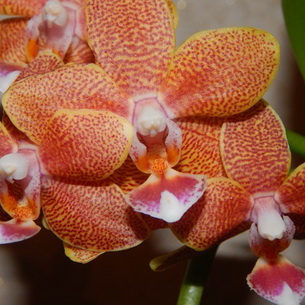
Phalaenopsis pulcherima - Phalaenopsis pulcherrima. This species is somewhat different from other members of the genus. It has its own history, for a long time it was considered a separate genus, like Doritis pulcherrima, called Phal. esmeralda. It has pointed leaves 20–25 cm long. The slender, tall peduncle bears many flowers with a diameter of 2.5–3 cm. Sepals and petals range from white to amethyst. The lateral lobes of the lip range in color, from purple to orange to brownish red; the middle lobe is purple, pointed. Two antennae appear behind the crest at the base of the middle lobe of the lip. This species of Phalaenopsis orchid grows in Cochin (China).
Group II, Stauroglottis
The lip of plants of this group has no processes, and the petals are closer in size to the sepals. The plants are smaller than those of group I, and the flowers, although smaller, are usually brightly colored, often with beautiful stripes and spots.
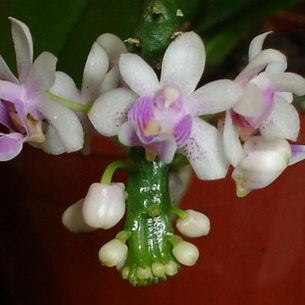
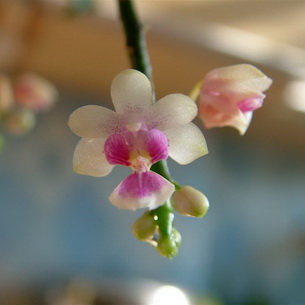
Phalaenopsis dekumbens - Phalaenopsis dekumbens. Long called Phalaenopsis amethystina, this species is a small plant with wavy leaves around the edges. The cream flowers have a rich, amethyst purple lip with white stripes and patterns. Grows in Java and Sumatra, blooms in autumn.
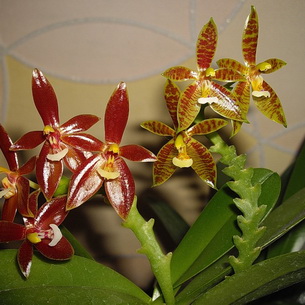
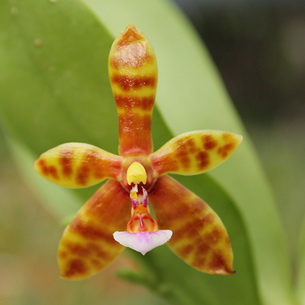
Phalaenopsis cornu-cervi - Phalaenopsis cornu-cervi. Yellow-green flowers with brown stripes, with a white lip, are loosely arranged on a peduncle whose shape resembles a deer horn. It is a naturally falling species, but does not require a dormant period in a greenhouse. It grows in Burma and Java and blooms throughout the year.
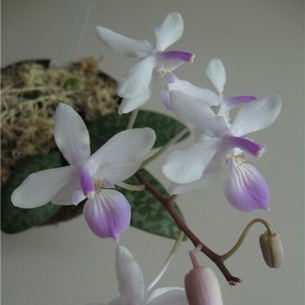
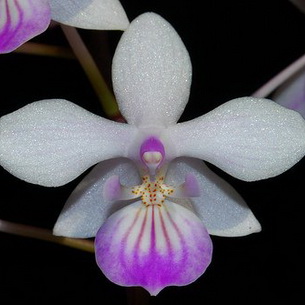
Phalaenopsis Linden - Phalaenopsis lindenii. A free blooming species with narrow speckled leaves and 5 cm flowers with pink petals and sepals. The lateral lobes of the lip have brown spots, and the pink middle lobe has purple streaks. The species grows in the Philippines and blooms from March to August.


